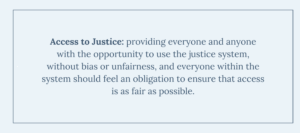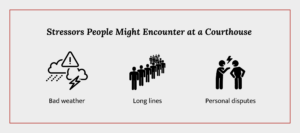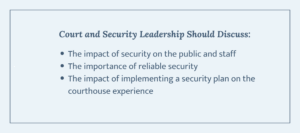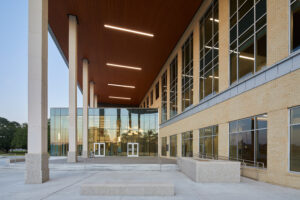
Working Together: Courthouse Security and the Impact on Access to Justice
The Evolving Understanding of “Access to Justice”
In the last decade, the concept of “access to justice” has grown from a focus on physical location, such as the geography and proximity of courthouses for all citizens, to a much deeper idea – everyone has the constitutional right to justice. Courts nationally have been breaking down barriers that may inhibit access, whether they be physical barriers for people with disabilities, cultural barriers for diverse populations, economic barriers, technological barriers, and so on. Providing access to justice means providing everyone and anyone with the opportunity to use the justice system, without bias or unfairness, and everyone within the system should feel an obligation to ensure that access is as fair as possible.

A Rough Entrance
Many years ago, I had an experience that helped me better understand a connection between courthouse security and access to justice that perhaps is rarely considered but could have a profound impact on the outcome of someone’s interaction with the courts.
I had several meetings scheduled at a certain courthouse for a project I was working on. Incidentally, the Security Captain was first on my list of meetings and security was likely prominent in my mind (and perhaps why I was more sensitive than usual during my experience with the officer at the screening station on the way in). It was a winter day, I had on a heavy coat and scarf. The line for security screening was out the door so I had to wait in the cold for a little while as the line crawled forward. Once inside, the high ceiling in the old courthouse reverberated a multitude of sounds in the noisy atrium. The snaking line, twisting through an historic atrium never designed for modern courthouse security, was packed with wearying visitors. The tension was palpable in people’s faces – an older man clutching a cap, a woman navigating a stroller around turns, annoyed security staff shepherding us to the screening stations…
It’s my turn to get screened. I put my bag on the x-ray machine belt and watch it disappear into the darkness within the machine. My keys and wallet go in a dish, and I watch them follow my bag. Stepping through the magnetometer, the alarm goes off. The officer is glaring at me.
“Did you take everything out of your pockets?”
“Um, yeah, I think so.” I pull out a pair of innocuous gloves from my coat.
“Which part of ‘take everything out of your pockets’ didn’t you understand?”
“Uh, these are just gloves…”
Off comes my coat, I set off the alarm again, another officer wands me and finds… nothing. I gather my things and go visit their boss. (No, I didn’t end up complaining about the officers to her. In fact, the whole interaction actually made me feel really bad, like I had unintentionally managed to make the officers’ morning worse somehow.)
We’re Not at Our Best When We’re Stressed
What does this story have to do with “access to justice?” Think about who is coming to the courthouse. They could be a driver contesting a traffic ticket; a tenant or landlord in a housing dispute; a victim filing for a protection from abuse order; a parent of a defendant coming to support their child in court. In a courthouse, someone could lose substantial amounts of money, their home, custody of their children, their freedom…
Point being, the overwhelming majority of visitors entering the courthouse do not want to be there! They are stressed and anxious long before they arrive. There is a high likelihood that they will be in the presence of someone with whom they are in an active conflict, such as someone from a recent intimate relationship, an opponent in a civil lawsuit, an abuser, someone from a rival gang or the arresting officer responsible for their court appearance. All that considered, what is the right way to welcome someone in a heightened state of stress to a courthouse?
Those first steps are paramount. What happens at the front door of a courthouse or criminal justice facility is so important for setting the tone for every visitor’s experience. Will someone have to wait outside in bad weather to enter the courthouse? Once inside, will the courthouse feel safe? If someone’s journey adds stress to their emotions, what will this do for someone’s frame of mind when engaging in court business? Will they be able to speak openly with their attorney, respond to a judge respectfully, plead their case effectively? If court staff enter through the front door and immediately must navigate through a congested and chaotic environment, how will their ability to serve the courts and the public be affected by their interactions with security? Will added stress be an impediment to someone’s fair access to justice?

But We Still Need Security
When we head to the airport, nobody likes the experience of going through security screening, yet we understand why we need to do it. There are a lot of things that could go wrong while traveling, and if we needed to add fear of a hijacking, heaven forbid, to our list of concerns, then we’d be even more distracted and anxious. We are fortunate in the U.S. that we can take for granted how extremely rare it is for crimes to occur once we clear the security check. Yes, security screening is never fun, and a smart traveler is always alert and vigilant, but our experience at the airport would be a whole other level of anxiety without security screening and surveillance present to protect us.
As is the case with the airport, there is no question that reliable security is essential to a modern courthouse. The potential for conflict is inherent in an environment that is intended to address conflict between people and where the government determines the fate of defendants against criminal charges. Security at the entrance is crucial for controlling who and what is allowed inside, and additional security inside is crucial for maintaining a place of safety, as best as possible, for everyone in the courthouse. Reducing the potential for violent conflict is a good thing, and it can impact how people feel when they are there, whether they be litigants, attorneys, defendants, clerks, judges…everyone is impacted.

What Can Be Done? Striking the Right Balance
To ensure that courthouse security is a positive element in supporting access to justice, it is important to recognize how these issues are related. It may sound cliché to say that acknowledging the relationship is the first step, but it is true that challenges cannot be addressed if they are not recognized for what they are. Court and security leadership should discuss how security impacts the public and staff; how important reliable security is; and how implementation of a security plan impacts the courthouse experience for people. Identifying goals and priorities as a team is crucial. From there, you may be asking, “what can be done?” The following are a few recommendations to get you and your team off to the best start when it comes to striking the right balance between effective security operations and maximizing access to justice:
Start From the Beginning
Take a good look at the courthouse entrance. Is there enough space for visitors to queue in line without feeling crowded, or even worse, standing outside in the elements? If not, is it possible to create more space for security screening without compromising the courthouse lobby or circulation area? If creating adequate space is not possible, perhaps there are ways to reduce the length of the security line operationally, such as by spreading out the peak visitor times through case scheduling (do all litigants need to show up first thing in the morning?); instructing jurors to arrive earlier than other courthouse visitors are permitted to enter; or using more video court to reduce the number of people who need to come in person to the courthouse overall.

One way to ensure visitors are protected from inclement weather is to provide ample covering where lines may form. Ascension Parish Courthouse is pictured as an example of this design.
If there is enough space and security staff to operate another screening station at a peak visitor time, adding another magnetometer will help clear the security line faster. Improving the nature of the entrance area with trauma-informed design – incorporating things like natural daylight, soothing color palettes, etc – also helps to reduce stress and anxiety in profound ways. Reducing the amount of time in line and improving the quality of the experience is a great way to start.
How You Train Security Staff Matters
The U.S. Marshals Service employs Court Security Officers (CSOs) to manage entrance security screening responsibilities at the entrance to federal courthouses. What strikes me about CSOs is how professional they always seem to be, not just in terms of competency but in their mannerisms. It seems that most CSOs have a good deal of ‘life seasoning’ (i.e. there’s a good deal of gray hair in their ranks), and that maturity brings a disarming calmness to their aura without compromising their firmness in directing visitors through security.
In contrast to the hothead from my story above, an officer who stays calm and respectful, even when facing off with someone who is being a jerk, has the superpower to de-escalate a situation. Remember, most visitors do not want to be in the courthouse, and they carry stress with them through the front door. It’s crucial to train personnel to understand that aggression may work against their ability to maintain a safe and secure environment, and that they can actually make their jobs easier if they reduce the anxiety felt by a visitor. These officers are the de facto welcoming committee and, therefore, a critical part of the court system.
Where Possible, Keep Them Separated
It was not uncommon in grade school for us as children to get into an occasional conflict with other classmates. What would our teacher do when we were not getting along? Separate us until the situation can be resolved.
Adults in conflict at a courthouse often fight worse than children, so it is imperative that there is the ability to keep them separated. Courthouses need appropriate space for separation. In areas where parties in conflict are likely to encounter each other, such as outside of a courtroom or in a clerk’s office waiting area, separate seating spaces should be provided. If there is a place in the courthouse where a heightened risk of emotionally charged conflict is real, such as in family court, perhaps a security officer post should be placed where an officer can keep a direct eye on things, and everyone can see they are being watched (just like the teacher!).
Many courthouses have designated ‘safe haven’ rooms for victims and witnesses to wait in until they are escorted to a courtroom, which is especially important for these most vulnerable people in the courthouse. In New York City, Safe Horizon in an organization that maintains safe waiting space in courthouses in addition to providing other services aimed at helping victims and children, such as acting as a third-party for support payments or as a gateway to social services for visitors in need. It is also common for prosecutor offices to host safe waiting rooms. The courts may also provide safe space as long as this does not compromise the role of the court to be a fair adjudicator in the justice process.

There are many important design elements that support access to justice including trauma-informed practices and design features. Click on the image above to download our Courthouse of the Future Ebook and dive deeper into these topics.
Design for Safety
There are quite a few aspects to a secure courthouse that should be addressed in design, including:
- Separate circulation zones for public, staff, and people in custody
- Secure building perimeter
- Effective entrance screening
- Thoughtful functional adjacencies
- Public areas with clear sightlines
- Secure transport and central holding area
- Effective deployment of security technology
It is recommended that a courthouse be evaluated on these aspects to assess how well the architectural design facilitates security. The appearance of good security will help ease the feelings of stress and anxiety for the people in the courthouse. Ensuring courthouse design effectively supports security goals will make the courthouse a safer place. There are many consultants out there that can help conduct security and operational assessments with an eye towards design for jurisdictions that want an objective evaluation and recommendations for improvements.
Bringing It All Together
Achieving the delicate balance between courthouse security and access to justice is crucial for ensuring that everyone who enters the courthouse feels safe, respected, and able to engage with the justice system effectively. While robust security measures are non-negotiable for maintaining safety in an inherently conflict-prone environment, it is equally important to consider how these measures impact the experiences of those seeking justice. By designing entrances thoughtfully, training security personnel to de-escalate rather than inflame tensions, and ensuring that spaces are configured to minimize conflict, courthouses can become not just places of order, but also places where justice is truly accessible.
